BMW 228I 2014 Owners Manual
Manufacturer: BMW, Model Year: 2014, Model line: 228I, Model: BMW 228I 2014Pages: 218, PDF Size: 6.6 MB
Page 161 of 218
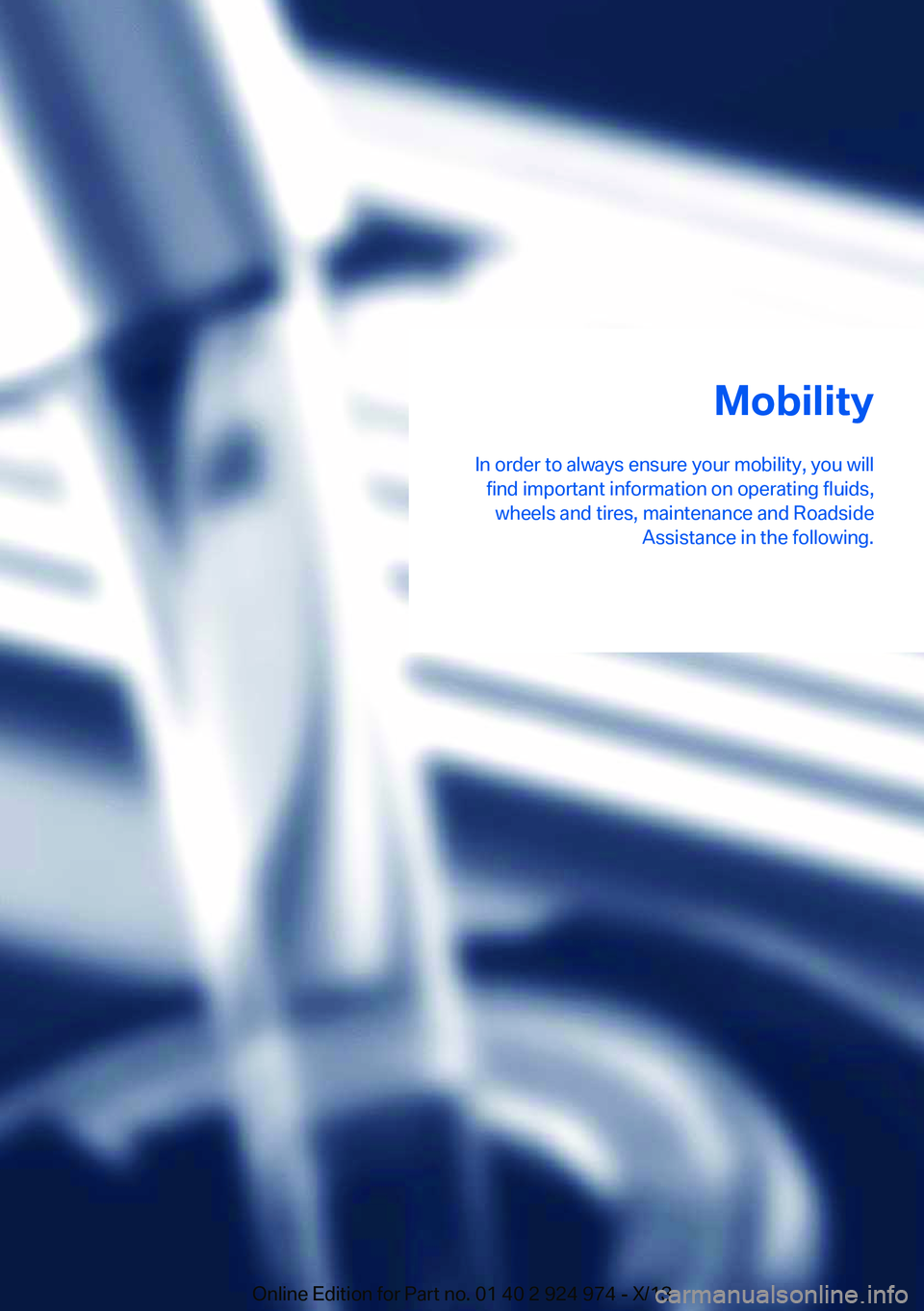
Mobility
In order to always ensure your mobility, you will find important information on operating fluids,wheels and tires, maintenance and Roadside Assistance in the following.Online Edition for Part no. 01 40 2 924 974 - X/13
Page 162 of 218
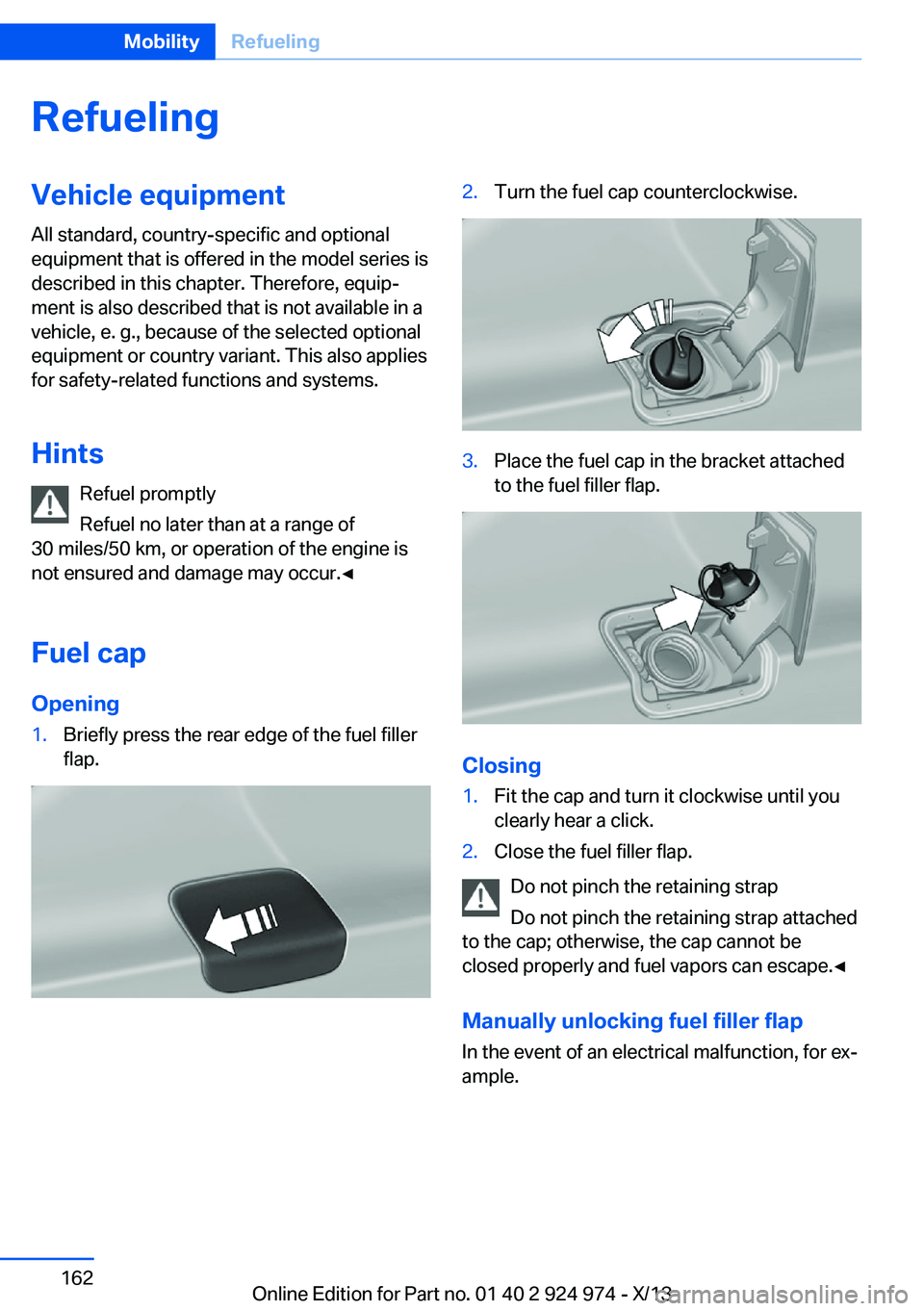
RefuelingVehicle equipment
All standard, country-specific and optional
equipment that is offered in the model series is
described in this chapter. Therefore, equip‐
ment is also described that is not available in a
vehicle, e. g., because of the selected optional
equipment or country variant. This also applies
for safety-related functions and systems.
Hints Refuel promptly
Refuel no later than at a range of
30 miles/50 km, or operation of the engine is
not ensured and damage may occur.◀
Fuel cap
Opening1.Briefly press the rear edge of the fuel filler
flap.2.Turn the fuel cap counterclockwise.3.Place the fuel cap in the bracket attached
to the fuel filler flap.
Closing
1.Fit the cap and turn it clockwise until you
clearly hear a click.2.Close the fuel filler flap.
Do not pinch the retaining strap
Do not pinch the retaining strap attached
to the cap; otherwise, the cap cannot be
closed properly and fuel vapors can escape.◀
Manually unlocking fuel filler flap In the event of an electrical malfunction, for ex‐
ample.
Seite 162MobilityRefueling162
Online Edition for Part no. 01 40 2 924 974 - X/13
Page 163 of 218
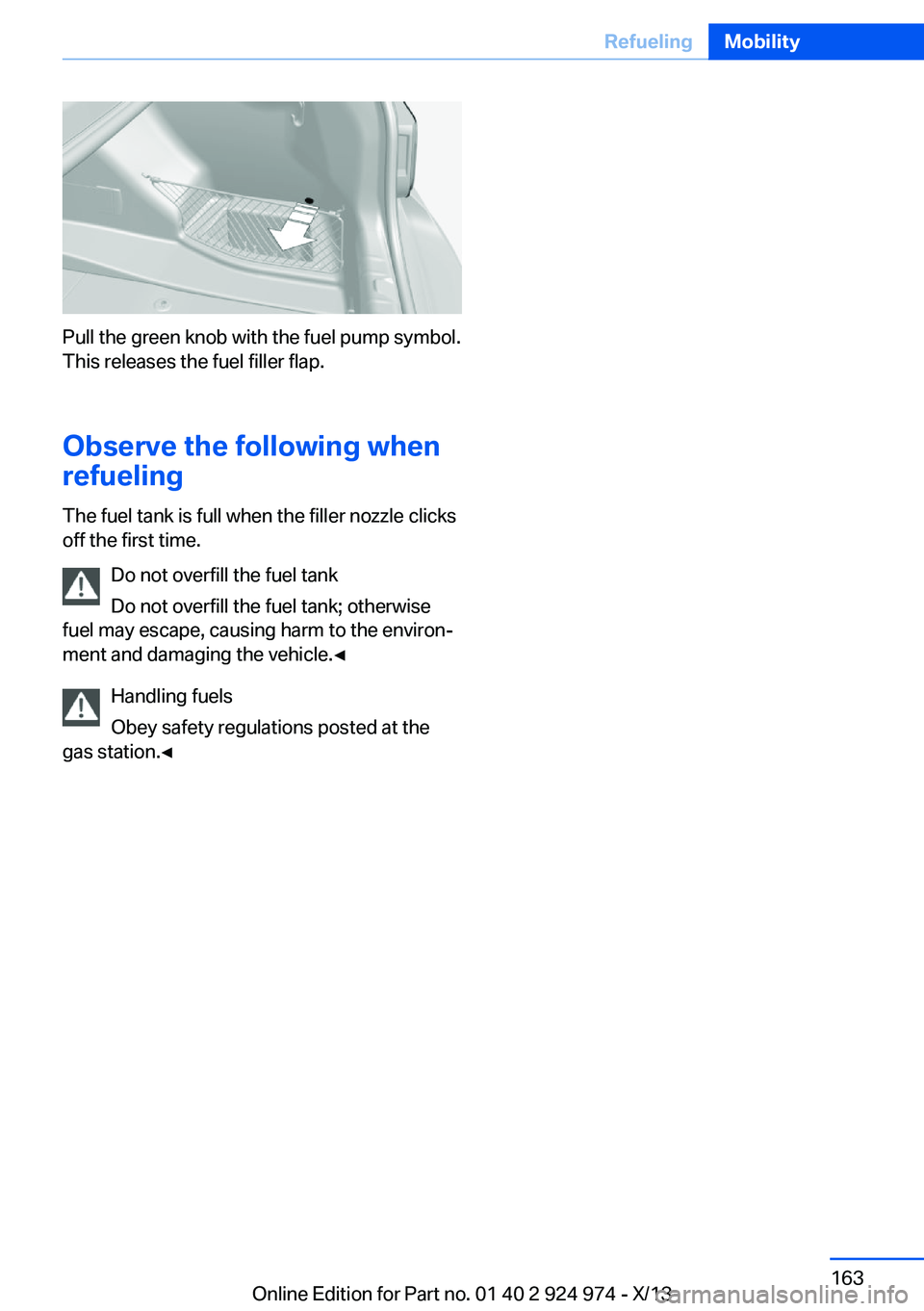
Pull the green knob with the fuel pump symbol.
This releases the fuel filler flap.
Observe the following when
refueling
The fuel tank is full when the filler nozzle clicks
off the first time.
Do not overfill the fuel tank
Do not overfill the fuel tank; otherwise
fuel may escape, causing harm to the environ‐
ment and damaging the vehicle.◀
Handling fuels
Obey safety regulations posted at the
gas station.◀
Seite 163RefuelingMobility163
Online Edition for Part no. 01 40 2 924 974 - X/13
Page 164 of 218
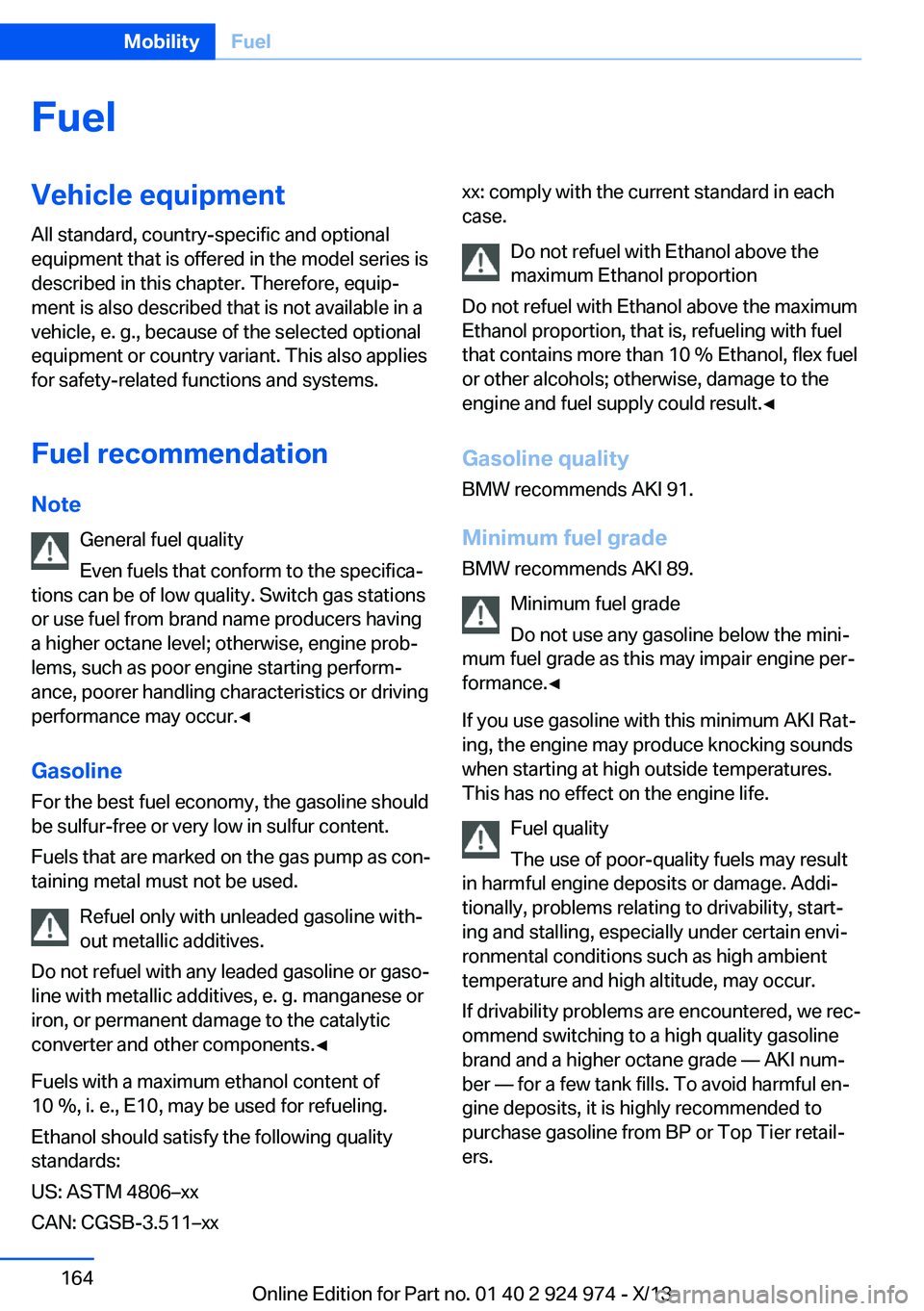
FuelVehicle equipmentAll standard, country-specific and optional
equipment that is offered in the model series is
described in this chapter. Therefore, equip‐
ment is also described that is not available in a
vehicle, e. g., because of the selected optional
equipment or country variant. This also applies
for safety-related functions and systems.
Fuel recommendation Note General fuel quality
Even fuels that conform to the specifica‐
tions can be of low quality. Switch gas stations
or use fuel from brand name producers having
a higher octane level; otherwise, engine prob‐
lems, such as poor engine starting perform‐
ance, poorer handling characteristics or driving
performance may occur.◀
Gasoline For the best fuel economy, the gasoline should
be sulfur-free or very low in sulfur content.
Fuels that are marked on the gas pump as con‐
taining metal must not be used.
Refuel only with unleaded gasoline with‐out metallic additives.
Do not refuel with any leaded gasoline or gaso‐
line with metallic additives, e. g. manganese or
iron, or permanent damage to the catalytic
converter and other components.◀
Fuels with a maximum ethanol content of
10 %, i. e., E10, may be used for refueling.
Ethanol should satisfy the following quality
standards:
US: ASTM 4806–xx
CAN: CGSB-3.511–xxxx: comply with the current standard in each
case.
Do not refuel with Ethanol above the
maximum Ethanol proportion
Do not refuel with Ethanol above the maximum
Ethanol proportion, that is, refueling with fuel
that contains more than 10 % Ethanol, flex fuel
or other alcohols; otherwise, damage to the
engine and fuel supply could result.◀
Gasoline quality BMW recommends AKI 91.
Minimum fuel grade
BMW recommends AKI 89.
Minimum fuel grade
Do not use any gasoline below the mini‐
mum fuel grade as this may impair engine per‐
formance.◀
If you use gasoline with this minimum AKI Rat‐
ing, the engine may produce knocking sounds
when starting at high outside temperatures.
This has no effect on the engine life.
Fuel quality
The use of poor-quality fuels may result
in harmful engine deposits or damage. Addi‐
tionally, problems relating to drivability, start‐
ing and stalling, especially under certain envi‐
ronmental conditions such as high ambient
temperature and high altitude, may occur.
If drivability problems are encountered, we rec‐
ommend switching to a high quality gasoline
brand and a higher octane grade — AKI num‐
ber — for a few tank fills. To avoid harmful en‐
gine deposits, it is highly recommended to
purchase gasoline from BP or Top Tier retail‐
ers.Seite 164MobilityFuel164
Online Edition for Part no. 01 40 2 924 974 - X/13
Page 165 of 218
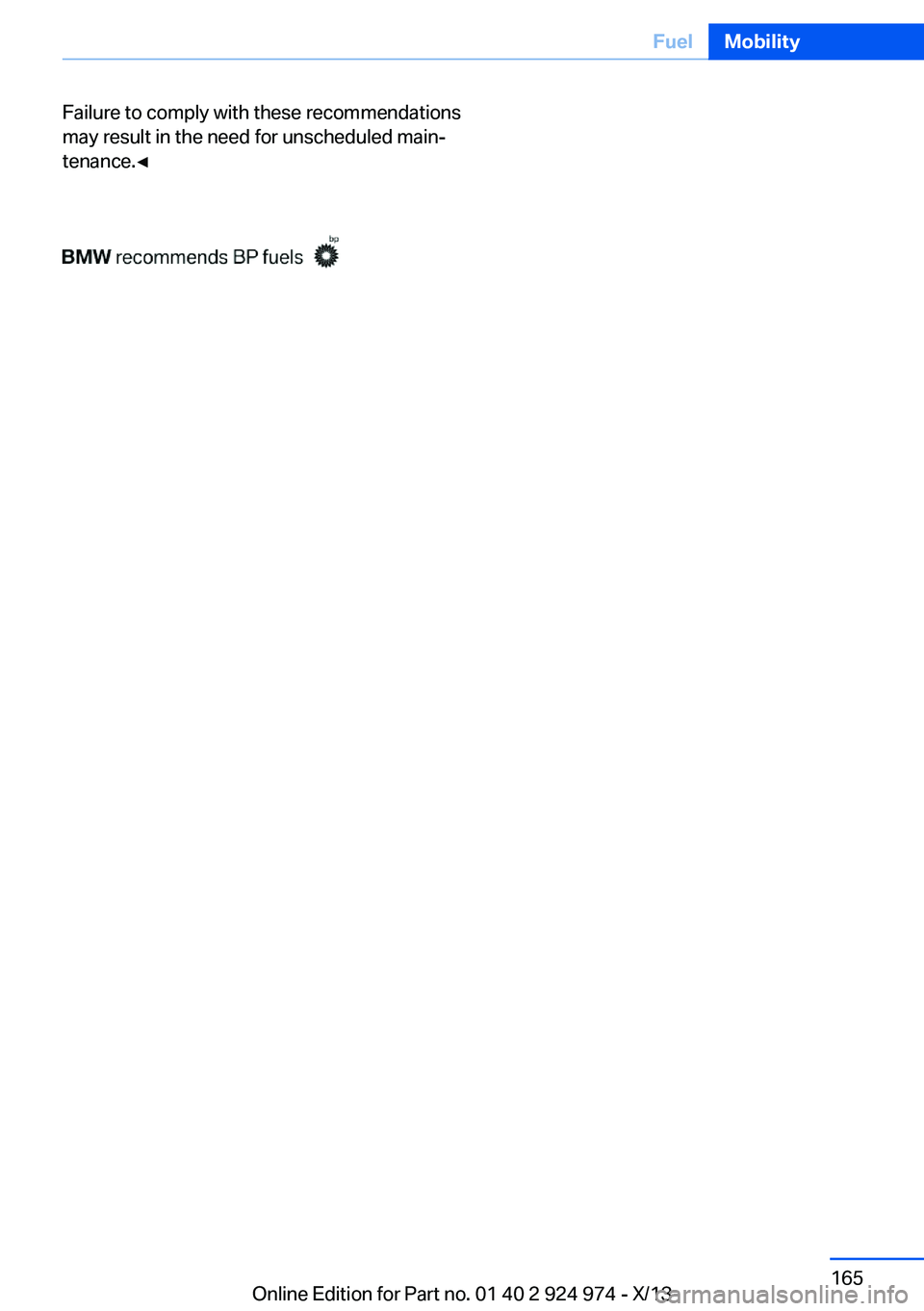
Failure to comply with these recommendations
may result in the need for unscheduled main‐
tenance.◀Seite 165FuelMobility165
Online Edition for Part no. 01 40 2 924 974 - X/13
Page 166 of 218
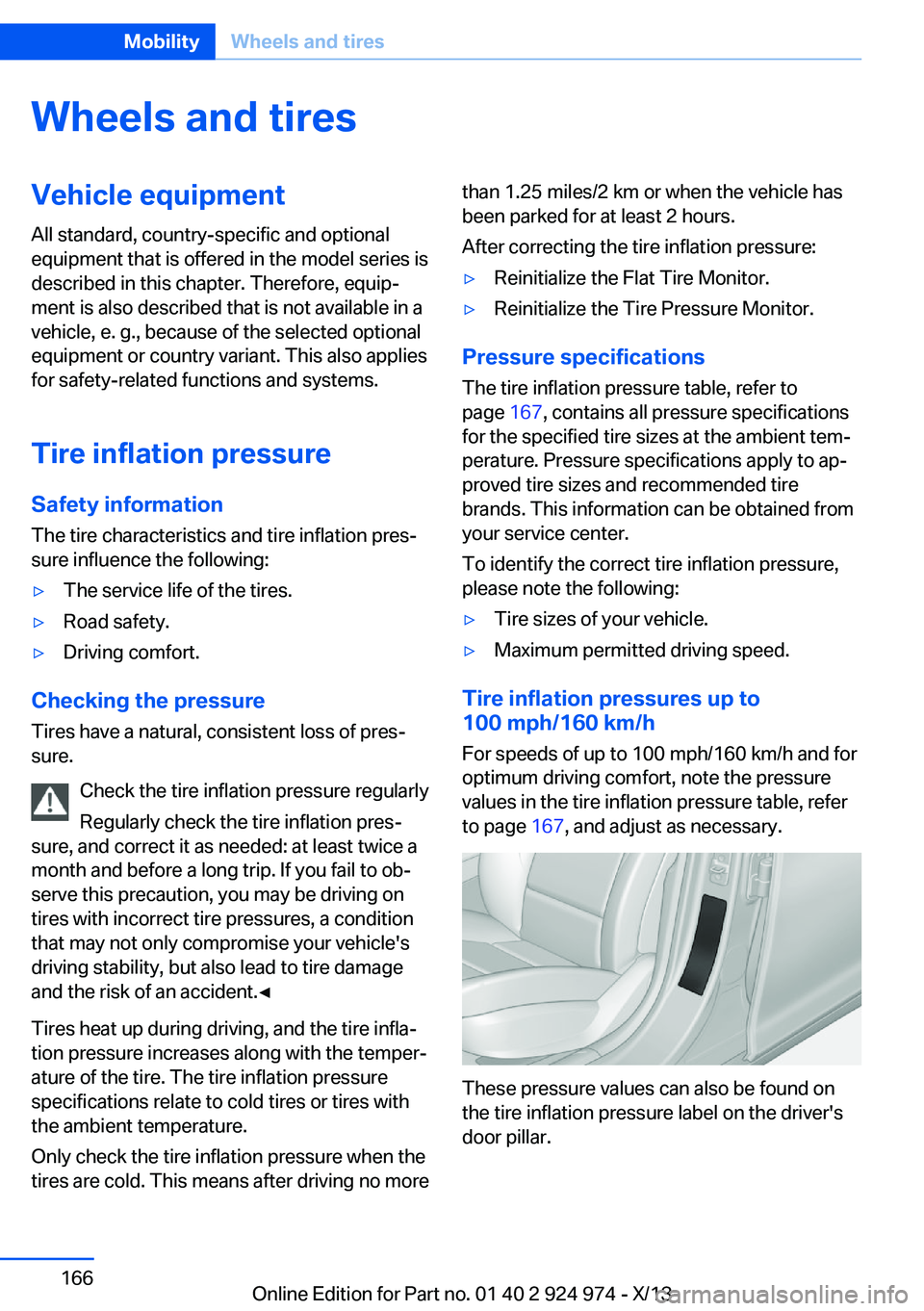
Wheels and tiresVehicle equipment
All standard, country-specific and optional
equipment that is offered in the model series is
described in this chapter. Therefore, equip‐
ment is also described that is not available in a
vehicle, e. g., because of the selected optional
equipment or country variant. This also applies
for safety-related functions and systems.
Tire inflation pressure Safety information
The tire characteristics and tire inflation pres‐
sure influence the following:▷The service life of the tires.▷Road safety.▷Driving comfort.
Checking the pressure
Tires have a natural, consistent loss of pres‐
sure.
Check the tire inflation pressure regularly
Regularly check the tire inflation pres‐
sure, and correct it as needed: at least twice a
month and before a long trip. If you fail to ob‐
serve this precaution, you may be driving on
tires with incorrect tire pressures, a condition
that may not only compromise your vehicle's
driving stability, but also lead to tire damage
and the risk of an accident.◀
Tires heat up during driving, and the tire infla‐
tion pressure increases along with the temper‐
ature of the tire. The tire inflation pressure
specifications relate to cold tires or tires with
the ambient temperature.
Only check the tire inflation pressure when the
tires are cold. This means after driving no more
than 1.25 miles/2 km or when the vehicle has
been parked for at least 2 hours.
After correcting the tire inflation pressure:▷Reinitialize the Flat Tire Monitor.▷Reinitialize the Tire Pressure Monitor.
Pressure specifications The tire inflation pressure table, refer to
page 167, contains all pressure specifications
for the specified tire sizes at the ambient tem‐
perature. Pressure specifications apply to ap‐
proved tire sizes and recommended tire
brands. This information can be obtained from
your service center.
To identify the correct tire inflation pressure,
please note the following:
▷Tire sizes of your vehicle.▷Maximum permitted driving speed.
Tire inflation pressures up to
100 mph/160 km/h
For speeds of up to 100 mph/160 km/h and for
optimum driving comfort, note the pressure
values in the tire inflation pressure table, refer
to page 167, and adjust as necessary.
These pressure values can also be found on
the tire inflation pressure label on the driver's
door pillar.
Seite 166MobilityWheels and tires166
Online Edition for Part no. 01 40 2 924 974 - X/13
Page 167 of 218
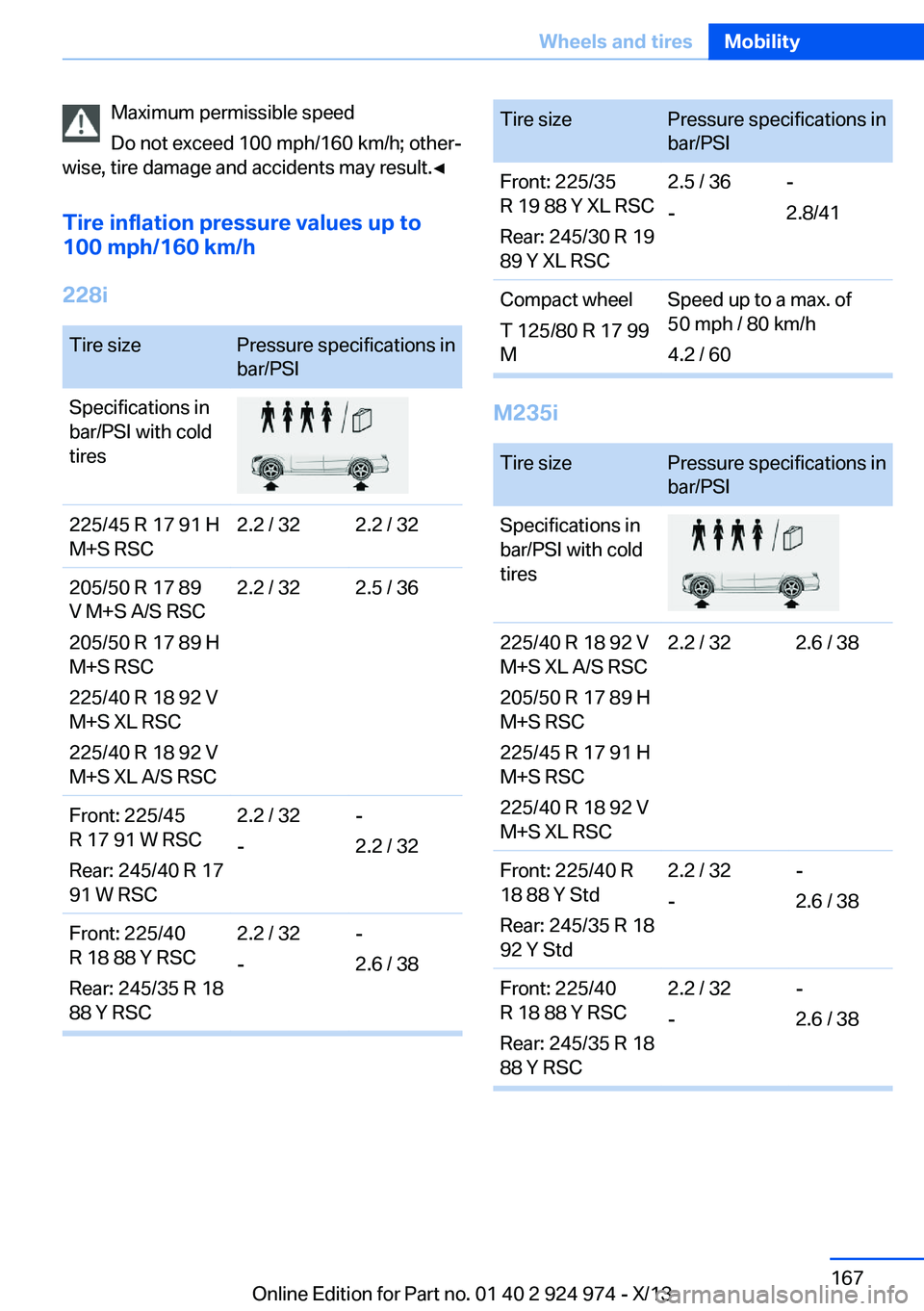
Maximum permissible speed
Do not exceed 100 mph/160 km/h; other‐
wise, tire damage and accidents may result.◀
Tire inflation pressure values up to
100 mph/160 km/h
228iTire sizePressure specifications in
bar/PSISpecifications in
bar/PSI with cold
tires225/45 R 17 91 H
M+S RSC2.2 / 322.2 / 32205/50 R 17 89
V M+S A/S RSC
205/50 R 17 89 H
M+S RSC
225/40 R 18 92 V
M+S XL RSC
225/40 R 18 92 V
M+S XL A/S RSC2.2 / 322.5 / 36Front: 225/45
R 17 91 W RSC
Rear: 245/40 R 17
91 W RSC2.2 / 32
--
2.2 / 32Front: 225/40
R 18 88 Y RSC
Rear: 245/35 R 18
88 Y RSC2.2 / 32
--
2.6 / 38Tire sizePressure specifications in
bar/PSIFront: 225/35
R 19 88 Y XL RSC
Rear: 245/30 R 19
89 Y XL RSC2.5 / 36
--
2.8/41Compact wheel
T 125/80 R 17 99
MSpeed up to a max. of
50 mph / 80 km/h
4.2 / 60
M235i
Tire sizePressure specifications in
bar/PSISpecifications in
bar/PSI with cold
tires225/40 R 18 92 V
M+S XL A/S RSC
205/50 R 17 89 H
M+S RSC
225/45 R 17 91 H
M+S RSC
225/40 R 18 92 V
M+S XL RSC2.2 / 322.6 / 38Front: 225/40 R
18 88 Y Std
Rear: 245/35 R 18
92 Y Std2.2 / 32
--
2.6 / 38Front: 225/40
R 18 88 Y RSC
Rear: 245/35 R 18
88 Y RSC2.2 / 32
--
2.6 / 38Seite 167Wheels and tiresMobility167
Online Edition for Part no. 01 40 2 924 974 - X/13
Page 168 of 218
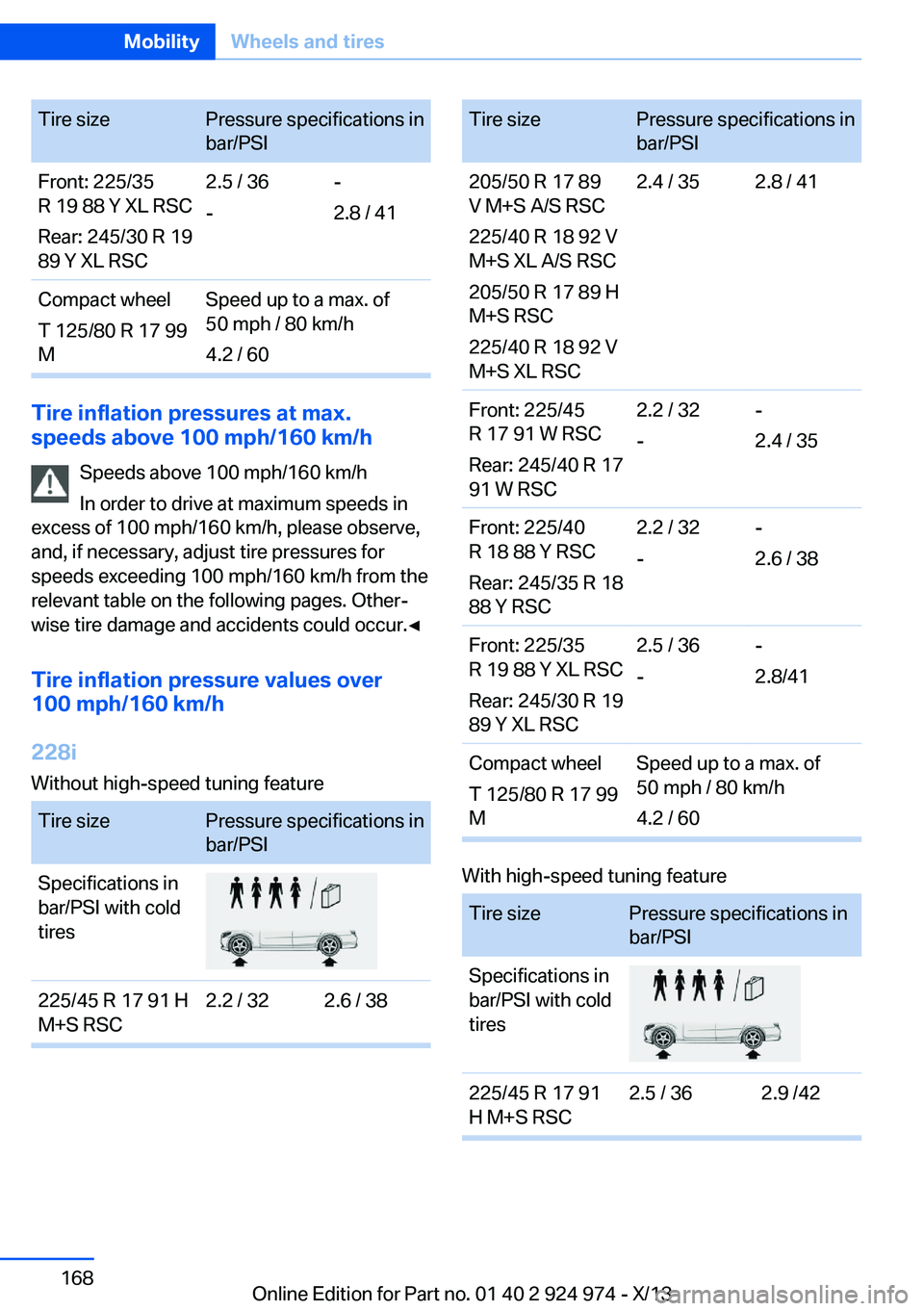
Tire sizePressure specifications in
bar/PSIFront: 225/35
R 19 88 Y XL RSC
Rear: 245/30 R 19
89 Y XL RSC2.5 / 36
--
2.8 / 41Compact wheel
T 125/80 R 17 99
MSpeed up to a max. of
50 mph / 80 km/h
4.2 / 60
Tire inflation pressures at max.
speeds above 100 mph/160 km/h
Speeds above 100 mph/160 km/h
In order to drive at maximum speeds in
excess of 100 mph/160 km/h, please observe,
and, if necessary, adjust tire pressures for
speeds exceeding 100 mph/160 km/h from the
relevant table on the following pages. Other‐
wise tire damage and accidents could occur.◀
Tire inflation pressure values over
100 mph/160 km/h
228i
Without high-speed tuning feature
Tire sizePressure specifications in
bar/PSISpecifications in
bar/PSI with cold
tires225/45 R 17 91 H
M+S RSC2.2 / 322.6 / 38Tire sizePressure specifications in
bar/PSI205/50 R 17 89
V M+S A/S RSC
225/40 R 18 92 V
M+S XL A/S RSC
205/50 R 17 89 H
M+S RSC
225/40 R 18 92 V
M+S XL RSC2.4 / 352.8 / 41Front: 225/45
R 17 91 W RSC
Rear: 245/40 R 17
91 W RSC2.2 / 32
--
2.4 / 35Front: 225/40
R 18 88 Y RSC
Rear: 245/35 R 18
88 Y RSC2.2 / 32
--
2.6 / 38Front: 225/35
R 19 88 Y XL RSC
Rear: 245/30 R 19
89 Y XL RSC2.5 / 36
--
2.8/41Compact wheel
T 125/80 R 17 99
MSpeed up to a max. of
50 mph / 80 km/h
4.2 / 60
With high-speed tuning feature
Tire sizePressure specifications in
bar/PSISpecifications in
bar/PSI with cold
tires225/45 R 17 91
H M+S RSC2.5 / 362.9 /42Seite 168MobilityWheels and tires168
Online Edition for Part no. 01 40 2 924 974 - X/13
Page 169 of 218
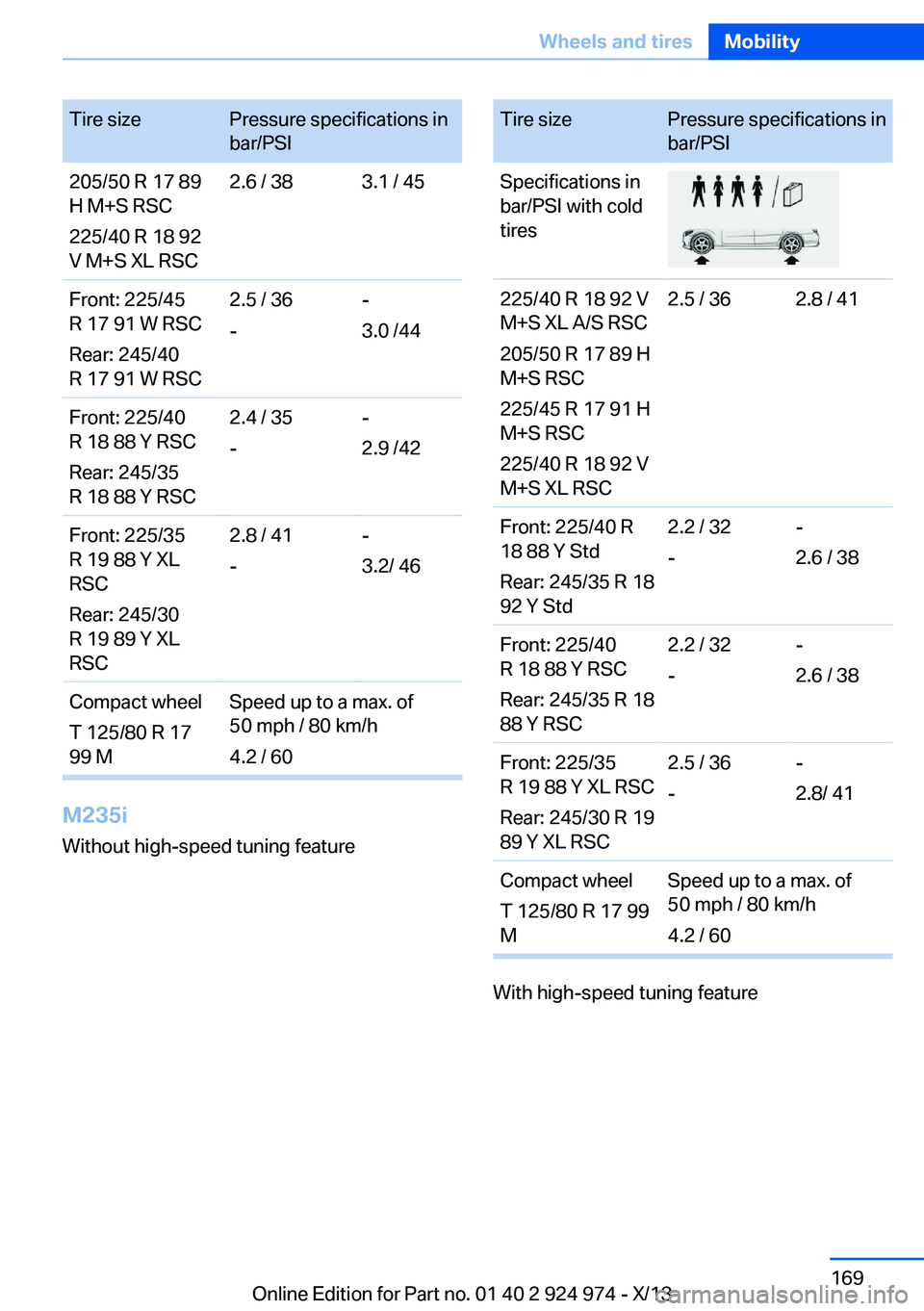
Tire sizePressure specifications in
bar/PSI205/50 R 17 89
H M+S RSC
225/40 R 18 92
V M+S XL RSC2.6 / 383.1 / 45Front: 225/45
R 17 91 W RSC
Rear: 245/40
R 17 91 W RSC2.5 / 36
--
3.0 /44Front: 225/40
R 18 88 Y RSC
Rear: 245/35
R 18 88 Y RSC2.4 / 35
--
2.9 /42Front: 225/35
R 19 88 Y XL
RSC
Rear: 245/30
R 19 89 Y XL
RSC2.8 / 41
--
3.2/ 46Compact wheel
T 125/80 R 17
99 MSpeed up to a max. of
50 mph / 80 km/h
4.2 / 60
M235i Without high-speed tuning feature
Tire sizePressure specifications in
bar/PSISpecifications in
bar/PSI with cold
tires225/40 R 18 92 V
M+S XL A/S RSC
205/50 R 17 89 H
M+S RSC
225/45 R 17 91 H
M+S RSC
225/40 R 18 92 V
M+S XL RSC2.5 / 362.8 / 41Front: 225/40 R
18 88 Y Std
Rear: 245/35 R 18
92 Y Std2.2 / 32
--
2.6 / 38Front: 225/40
R 18 88 Y RSC
Rear: 245/35 R 18
88 Y RSC2.2 / 32
--
2.6 / 38Front: 225/35
R 19 88 Y XL RSC
Rear: 245/30 R 19
89 Y XL RSC2.5 / 36
--
2.8/ 41Compact wheel
T 125/80 R 17 99
MSpeed up to a max. of
50 mph / 80 km/h
4.2 / 60
With high-speed tuning feature
Seite 169Wheels and tiresMobility169
Online Edition for Part no. 01 40 2 924 974 - X/13
Page 170 of 218
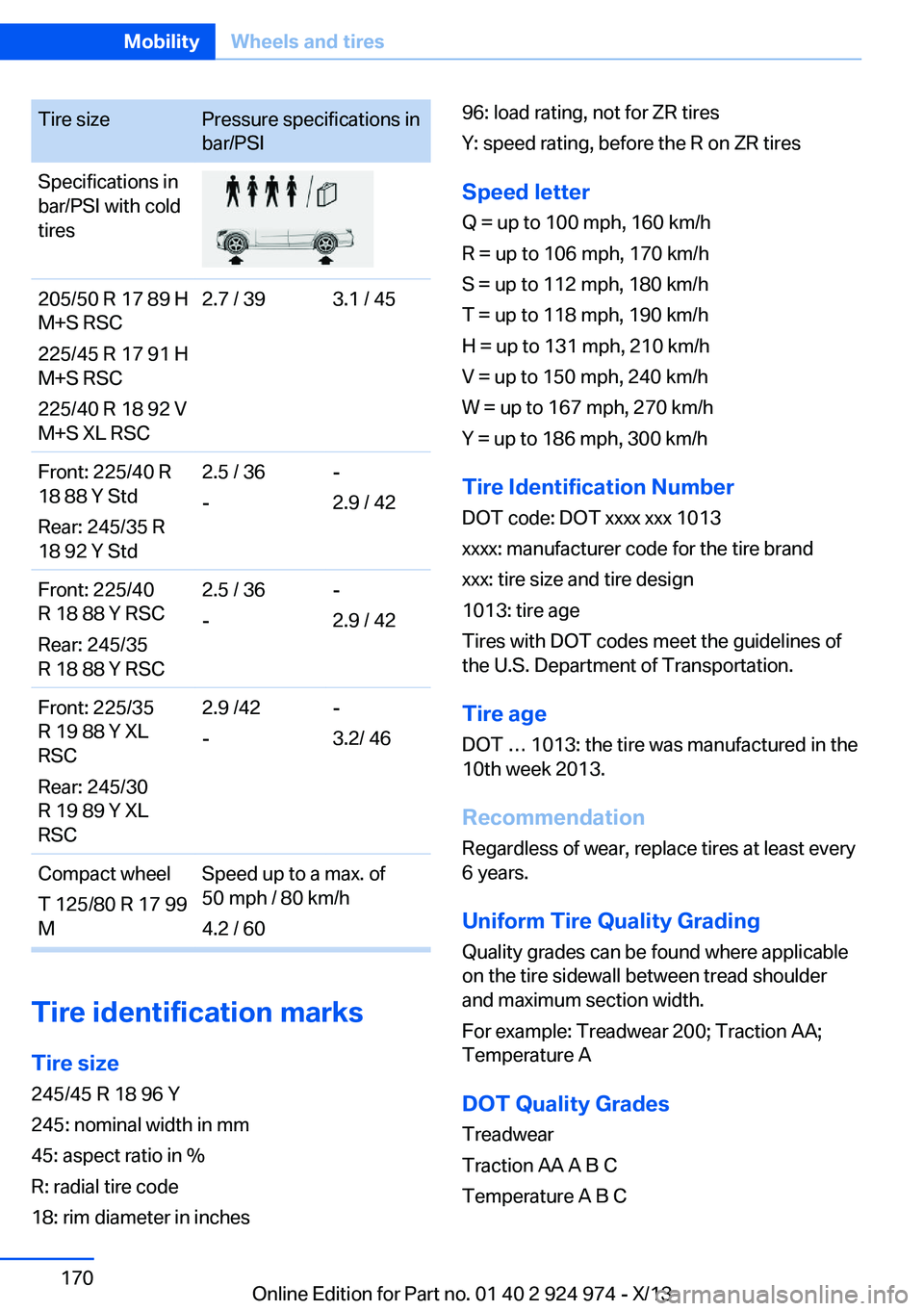
Tire sizePressure specifications in
bar/PSISpecifications in
bar/PSI with cold
tires205/50 R 17 89 H
M+S RSC
225/45 R 17 91 H
M+S RSC
225/40 R 18 92 V
M+S XL RSC2.7 / 393.1 / 45Front: 225/40 R
18 88 Y Std
Rear: 245/35 R
18 92 Y Std2.5 / 36
--
2.9 / 42Front: 225/40
R 18 88 Y RSC
Rear: 245/35
R 18 88 Y RSC2.5 / 36
--
2.9 / 42Front: 225/35
R 19 88 Y XL
RSC
Rear: 245/30
R 19 89 Y XL
RSC2.9 /42
--
3.2/ 46Compact wheel
T 125/80 R 17 99
MSpeed up to a max. of
50 mph / 80 km/h
4.2 / 60
Tire identification marks
Tire size 245/45 R 18 96 Y
245: nominal width in mm
45: aspect ratio in %
R: radial tire code
18: rim diameter in inches
96: load rating, not for ZR tires
Y: speed rating, before the R on ZR tires
Speed letter
Q = up to 100 mph, 160 km/h
R = up to 106 mph, 170 km/h
S = up to 112 mph, 180 km/h
T = up to 118 mph, 190 km/h
H = up to 131 mph, 210 km/h
V = up to 150 mph, 240 km/h
W = up to 167 mph, 270 km/h
Y = up to 186 mph, 300 km/h
Tire Identification Number
DOT code: DOT xxxx xxx 1013
xxxx: manufacturer code for the tire brand
xxx: tire size and tire design
1013: tire age
Tires with DOT codes meet the guidelines of
the U.S. Department of Transportation.
Tire age
DOT … 1013: the tire was manufactured in the
10th week 2013.
Recommendation
Regardless of wear, replace tires at least every
6 years.
Uniform Tire Quality GradingQuality grades can be found where applicable
on the tire sidewall between tread shoulder
and maximum section width.
For example: Treadwear 200; Traction AA;
Temperature A
DOT Quality Grades Treadwear
Traction AA A B C
Temperature A B CSeite 170MobilityWheels and tires170
Online Edition for Part no. 01 40 2 924 974 - X/13